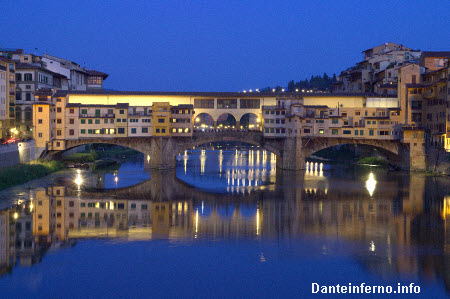
This page discusses the city state of Florence, during the time of Dante, the Renaissance author of the Divine Comedy (La Divina Commedia), of which the Inferno is the first book.

The poet Dante Alighieri was born in Florence, in 1265. It was a momentous time as Europe. and especially Italy, began to emerge from the ignorance and squalor of the Middle Ages. The first stirrings of the Renaissance were being felt in the city states of Italy. Florence was a rich mercantile city with imperial ambitions, locked in a conflict for supremacy of the Italian peninsula with its rivals Genoa and Venice. Its wealth and prestige attracted artists and poets who created marvelous works of art and literature.
However, just as the Italian peninsula was ravaged by war between the city states, the city of Florence itself was torn by internecine strife between two violently opposed political factions, the Guelphs and the Ghibellines. As Dante's fame as a poet grew and he became a prominent citizen of Florence, he was drawn into the political controversies of the day and, despite being one of Florence's greatest sons, was eventually banished by the opposing political faction, who had seized control of the city. Dante would die in exile far from his beloved Florence. However, he would have a measure of revenge. His masterpiece, the Inferno is peopled with a host of mythological as well as real people, many of whom were Dante's rivals in real life. Dante had the pleasure of consigning them all to his Hell, so that for was long as the Inferno is read, they will forever be known as one of the souls of the damned.
FLORENCE, a city of Italy, capital of a province of the same name, on the Arno River, about 140 miles northwest of Rome.
The site is in a beautiful valley surrounded by hills, while a number of bridges cross the Arno and join both portions. Several important railroad lines connect it with the commercial emporiums of Italy.

The public buildings include several beautiful palaces and impressive structures, and many piazzas or squares give the city a reputation for elegance and convenience. Among the principal buildings is the cathedral founded in 1298, and dedicated with much display and impressive ceremonies in 1887.
Michael Angelo found the dome of this historic structure a convenient model for Saint Peter's. In the cathedral are numerous sculptures by master artists, among them Michael Angelo. Other churches contain almost an equal wealth of master productions in sculpture and painting.
The celebrated buildings include the Uffizi, Vecchio, Signoria, Pitti, Strozzi, II Bargello, and Riccardi palaces. The cathedral of Santa Maria del Fiore is the most remarkable building in the city. Many eminent Tuscans were buried in the church of Santa Croce, which has many fine decorations and celebrated tombs, among them those of Galileo, Michael Angelo, Alfieri, and Machiavelli.
Dante's monument by Piazzi is situated in the Piazzi Santa Croce. A national library of more than 200,000 volumes and 12,000 manuscripts is located in the Pitti Palace, which also contains the celebrated Florentine gallery of art. Florence has numerous literary and educational establishments, a public school system, and institutions devoted to the arts, sciences, and higher educational interests. The Florence school of art is the most important in Italy.
Florence was founded by the Romans in the 1st century B. c., and probably named from Fiesole, a beautiful mountain near its site. It came under the dominion of Pope Gregory VII. in the 11th century, and by the middle of the 13th century it rose to commercial importance, ranking for many years as one of the first cities of Italy. An independent republic was established at Florence in 1283, and about fifteen years later great strife arose between rival parties under the names of Blacks (Ghibellines) and Whites (Guelphs), which resulted in the defeat of the latter and the banishment of the leading memhers, among them the poet Dante.
The republic fell in the 16th century and it was placed under Charles V. of Germany, who became known as the Duke of Florence, and was a member of the Medici. This dynasty ruled until 1737, when it was succeeded by Francis of Lorraine, who afterward became Emperor of Germany. The history of Florence is merged into that of Tuscany from that time until it became united with the kingdom of Italy. From 1864 to 1871 it was the provisional capital of the kingdom, whence dates its recent prosperity. Among the great men produced by Florence are Amerigo Vespucci, Galileo, Dante, Boccaccio, Michael Angelo, Vinci, Cellini, Andrea del Sarto, Medici, Machiavelli, and Petrarch.